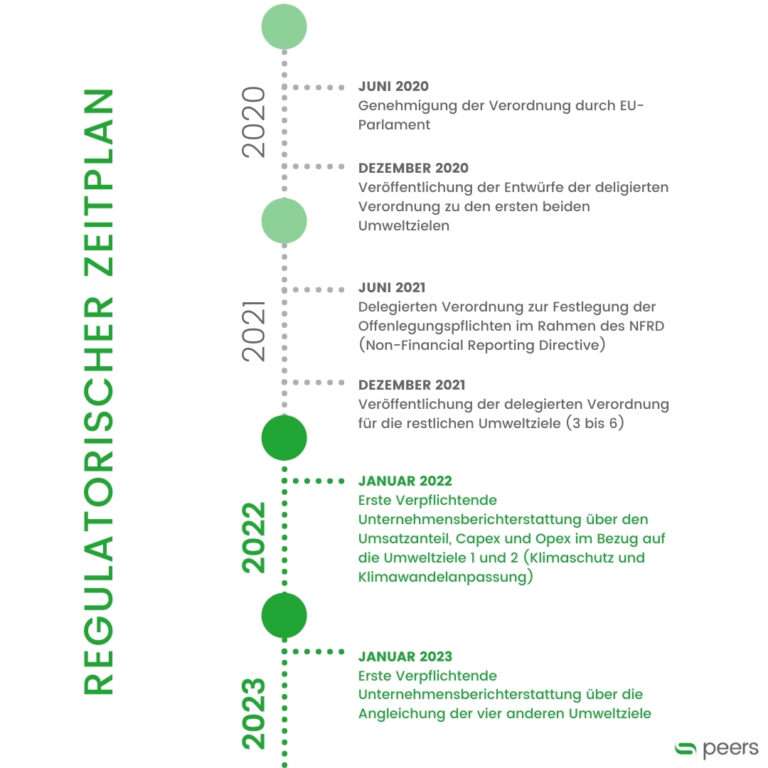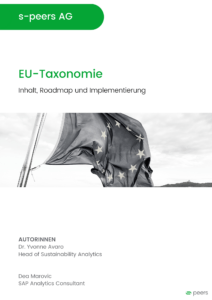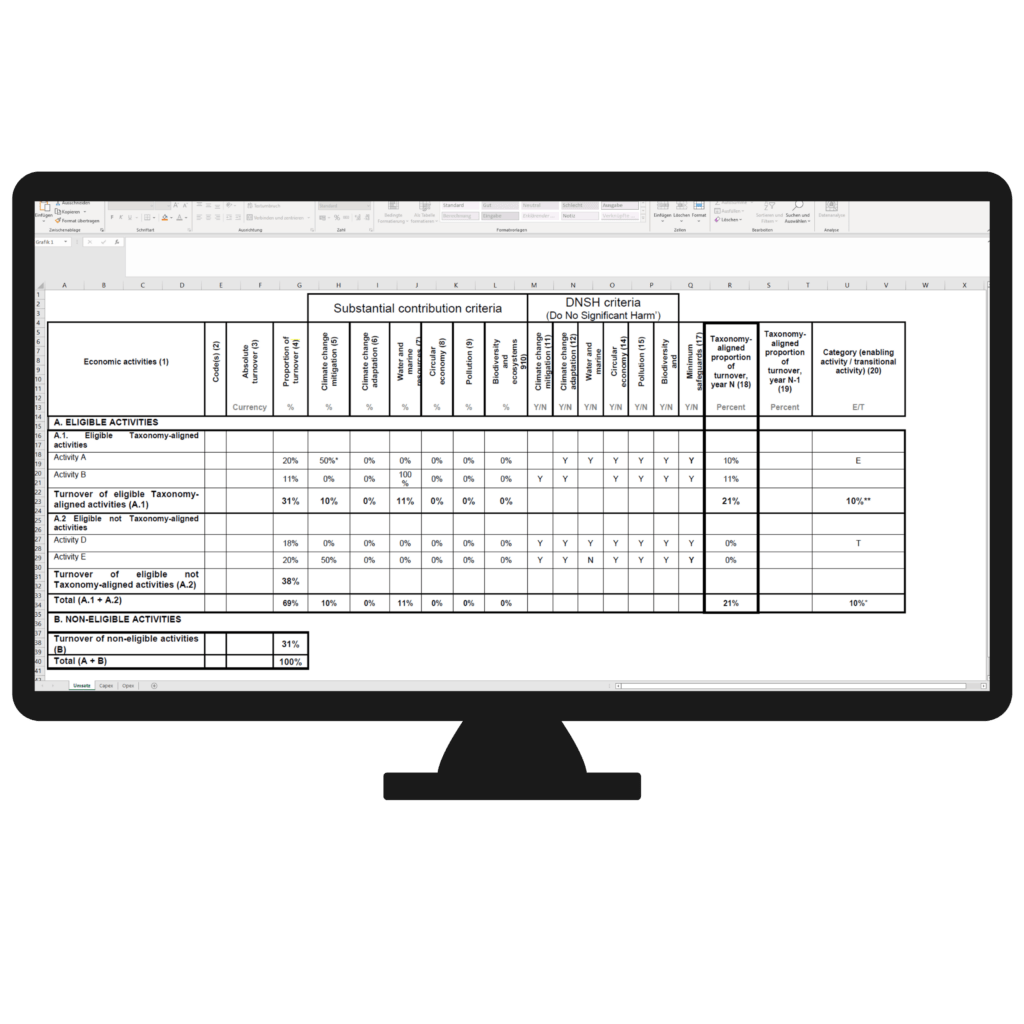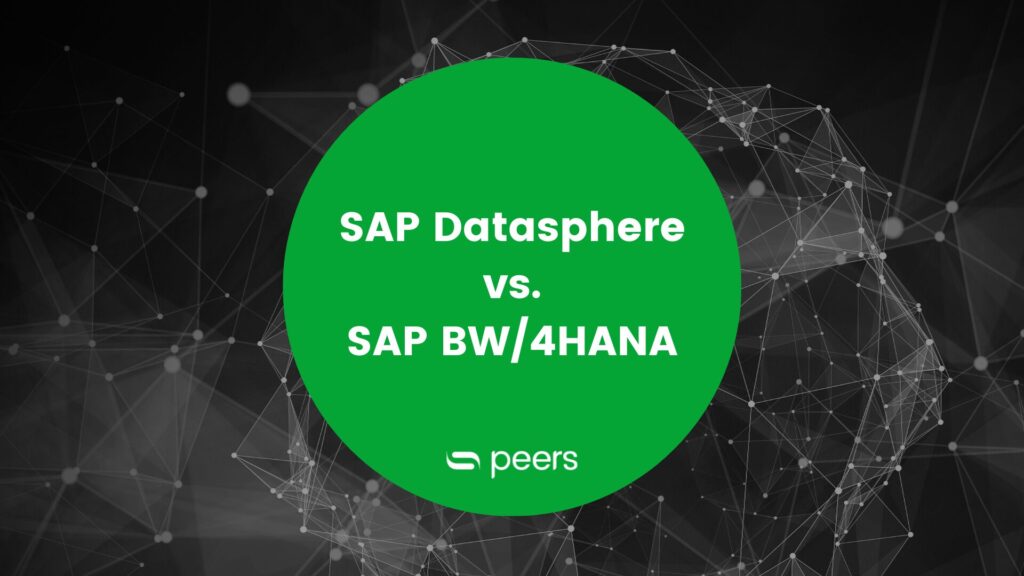EU taxonomy - implementation in an SAP Analytics system
- Sustainability Solutions
- 5 min reading time

Dea Marovic
Table of contents
- 1 EU taxonomy: Why action is needed now!
- 2 Initial situation EU taxonomy
- 3 E-Book EU Taxonomy
- 4 The 6 environmental objectives of the EU taxonomy
- 5 The 3 EU taxonomy criteria for sustainable economic activity
- 6 Frequently Asked Questions (FAQs) on the EU taxonomy
- 7 Successful implementation of the EU taxonomy in 6 steps
- 8 EU taxonomy implementation
EU Taxonomy: Why action is needed now!
The first reporting obligation will take effect early after the adoption of the Taxonomy Regulation in June 2020, from 1 January 2022.
The EU taxonomy applies to "all capital market-oriented companies", thus to almost all companies!
On the one hand, reporting companies must have appropriate sustainability certifications from their suppliers. On the other hand, financial institutions, which are also mandated by EU classification rules, expect appropriate disclosure: This is needed so that the financial institutions' clients can assess whether the investments are sustainable.
The EU is planning to ensure that only companies that achieve X% of the climate targets will receive loans from the capital market. This already needs to be documented, and it is also an important trend in the long term. Therefore, it is a simple step to record this as well.
Initial situation EU taxonomy

As part of its climate policy positioning and as a result of the Paris Climate Agreement, the European Commission presented the European Green Deal in December 2019. With the Green Deal, the Commission proclaims the goal of reducing net emissions of greenhouse gases in the European Union to zero by 2050 and thus becoming climate neutral.
To support the alignment and financing of the Green Deal, financial flows are to be diverted into "environmentally sustainable" activities. For this purpose, the EU Sustainable Finance Taxonomy (hereafter: EU Taxonomy) was developed, a classification system to clearly define "environmentally sustainable" business activities.
The new reporting requirements associated with the EU taxonomy are likely to significantly increase the informative value of non-financial reporting. This works by establishing a link between financial and non-financial topics for the first time. They will be relevant for the capital market to fulfill their own reporting obligations. Conformity with the EU taxonomy therefore requires early and intensive consideration of these topics in the reporting companies.
The first reporting obligation takes effect early after the adoption of the Taxonomy Regulation in June 2020 as of 1 January 2022. Thus, you have to take care of the implementation of the EU Taxonomy in a timely manner.
E-Book EU Taxonomy

The 6 environmental objectives of the EU taxonomy
The 3 EU taxonomy criteria for sustainable economic activity
According to the taxonomy, companies generate sustainably if they support at least one of these goals in a sustainable manner.
The DNSH(Do No Significant Harm) criterion is met. The economic activity does not affect any other environmental objective.
Minimum social standards, such as the OECD Guidelines for Multinational Enterprises, the International Labour Organisation's Labour Standards and the United Nations Guiding Principles on Business and Human Rights, must be met.
"As the economist Peter Drucker said: "If you can't measure it, you can't manage it!
It is the same with the EU taxonomy. Only those who know how sustainably the company operates can also change and optimise this."

Frequently Asked Questions (FAQs) on the EU Taxonomy
- Companies (>500 employees) that fall under non-financial reporting
- Financial institutions + providers Occupational pensions selling their products in the EU
- European institutions dealing with the classification of sustainable financial products
According to the EU taxonomy, the following parts of economic activity are to be disclosed in conformity with the EU taxonomy:
- Turnover (revenue from the sale of products)
- CapEx (capital expenditure on longer-term fixed assets, such as machinery)
- OpEx (costs of operating expenses, such as raw materials and energy costs)
The EU taxonomy is a content of non-financial reporting. Thus, the EU taxonomy reporting can be a:
- Part of the Annual Report
- or a single sustainability report
- ESMA(European Securities& Markets Authority) has provided a proposal for the presentation of the reporting in its final report "Advise on Article 8 of the Taxonomy Regulation".
- The proposal shows uniform reporting for turnover, OpEx and CapEx.
- The first dimension (rows) is always divided into "taxonomy-aligned" and "not taxonomy-aligned" economic activities.
- The second dimension (column) divides into:
- Ratio turnover, OpEx, CapEx in %
- Fulfilment of the 6 environmental targets of the EU taxonomy in %.
- DNSH criterion(Do No Significant Harm): Documentation of the expression in Yes/No
- and a comparison with the previous year
- In theshort term, the EU taxonomy is only relevant for Swiss companies if they generate value added within the EU.
- In the long term, however, this may change. In its report " Sustainability in the Swiss Financial Sector", the Swiss Federal Council writes that it sees the topic of sustainable finance as very relevant for the Swiss financial market. Although the Federal Council does not see a 1:1 implementation of the EU taxonomy, it would like to follow it.
- This provides an indication that regulatory intervention is also to be expected in Switzerland in the long term. It is important to react strategically and to deal with the issue of the EU taxonomy in a timely manner, even as a Swiss company.
Understanding of terms EU taxonomy, definition of stakeholders, setting timing
Identification of the taxonomy-eligible activities (turnover, CapEx, OpEx) with the appropriate KPIs as well as their characteristics
Data collection for selected financial ratios defined with the departments and stakeholders.
Concept for system-technical implementation in SAP BI technology, e.g. SAP BW, SAP BO DM or other technologies
Discussion of the created key figures and preparation of the reporting and commenting on the key figures
Summary of the success of the project
EU taxonomy implementation

We estimate that this project will require 30 external consultant days. The Accounting, Controlling and Sustainability departments should also have sufficient resources to conduct workshops or meetings on a selective basis.
The auditing company cooperating with s-peers is available on call with 3 to 5 person days.
Published by:

Dea Marovic
Lead Sustainability & Professional Analytics Consultant

Dea Marovic
How did you like the article?
How helpful was this post?
Click on a star to rate!
Average rating 0 / 5.
Number of ratings: 0
No votes so far! Be the first person to rate this post!







